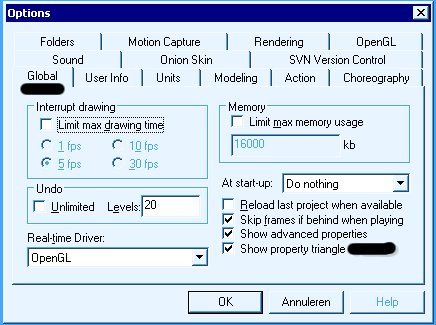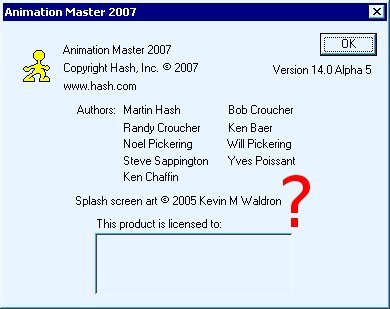
C-grid
-
Posts
463 -
Joined
-
Last visited
Content Type
Profiles
Forums
Events
Posts posted by C-grid
-
-
Drop me a project file and I'll post you some settings.
Help me help you.

I helped myself, after replies got deleted(the ones I did try sending).
Great anger was given and once a project was ask to prove, on which I spent 2 days making, got deleted within a minute.
I did quite some thoroughly 'research':
I noticed 3 types of jitter:
- Image-jitter due distance
- Image-animated-jitter due dynamic applying the (decal-)image
- Geometry-jitter, "flying towards a house without texture-applied" shows jitter in the model
ps.
The solution should be at Hash or through the TWO-project, dunno
ps2.
Rodney, if you didn't belong to the ignorent, you posted already 'settings' since the problem isn't 'hard to tell'(see your post).
-
He asked for render settings and solutions Niels.
Yes, that's what I was afraid of..., where are your settings and solutions you gave that solved the 3 types I mentioned?
The ones where an 'orangeskin' can't be an 'orangeskin' don't apply

-
Its hard to say without reference or a project file.
It sounds like your material is high frequency and generating artifacts.
One way to defeat high frequency materials and cut render time is to convert your materials to decals.
In some cases (problematic camera angles) you may need to explore more than that.
To test it however and isolate it to your Darktee material try substituting a simpler, lower frequency, material. Adding one color back in at at time for best feedback.
I render 1 animation short (TGA sequence), when the camera zoom or pan the line have flicker (shake). My model is using simbont AM. I use multi-pass 49 (7x7) render also have this problem.What render setting i should be to do? please help me. thank q.

I noticed 3 types of jitter:
- Image-jitter due distance
- Image-animated-jitter due dynamic applying the (decal-)image
- Geometry-jitter, "flying towards a house without texture-applied" shows jitter in the model
ps.
The solution should be at Hash or through the TWO-project, dunno

-
I render 1 animation short (TGA sequence), when the camera zoom or pan the line have flicker (shake). My model is using simbont AM. I use multi-pass 49 (7x7) render also have this problem.
What render setting i should be to do? please help me. thank q.

I noticed 3 types of jitter:
- Image-jitter due distance
- Image-animated-jitter due dynamic applying the (decal-)image
- Geometry-jitter, "flying towards a house without texture-applied" shows jitter in the model
ps.
The solution should be at Hash or through the TWO-project, dunno

-
Sorry. My bad. I guess i read it to fast. Still i would advise using the plugin sweeper if you want to model any type of vine. There is a good tutorial on the sweeper site.
I'm glad you didn't read it with anger. (It wasn't enclosed when I sent it)

-
I would not use hair to model a vine. Try using the plugin sweeper. You will have better results
Clone, before " spittin' ", did you notice the distiction between:
A.
Well I'm in the process of using hair to create foilage. So far so good.B.
Now I need to model a vine. I was thinking of using splines to simulate the vine. -
can i use a single spline as an emitter?"
Yes, when you use the 'Shag Emitter', sometimes refered to as 'the old hair-system' but when using the newer 'Hair System', you need surface(patch(es)).
You probably want the 'Hair System' for foliage use, but I don't know which planet you're going to dress-up
 Can an emmited object be given more flex points like an emmited streak?
Can an emmited object be given more flex points like an emmited streak?If you mean splinage-density, yes.
Else if you mean more than one material, 'like another e.g. streak-material', yes.
-
I also liked Kin's compositions, it seems you have alot todo, if you accept getting 'involved';
Do your best when you do, will you

-
The problem could reside in:
- A:M 10.5 handling the import plug
- The .3ds-importer plug
- A different version support of the .3ds-format specification
- The way a .3ds-model is polygon'd as a start
Things you could try:
- Ask someone with a newer A:M to try the import of the specific .3ds-file.(Or upgrade yourself)
- Check if there's a change in the .3ds-import plug version for A:M (Or different kind of format importers)
- You could try re-saving the .3ds-model in another 3d-polygon program(try changing format-version) or re-save it in a different format like .obj or .lwo(I dunno if there's any importer for .obj or .lwo in version 10.5)
- You could split the .3ds-model up, try to import it in AM and find where 'the boggle' is...
A program closing in e.g. Windows, has todo with the program generating a general protection fault, this relates to a processor-exception or OS-exception(alot of times memory).
The importer-intelligence has trouble creating and connecting CPs, makin' splines, is my suspicion, 'following' the 'flow' of the spline(s).
A work-around for such models is maybe using the 'newer' feature Topology and re-create a leaner model for export.
Knowing how to spline, is maybe the best answer

You could take screencaptures for use in A:M to rotoscope and skip the topology-part. (You're model isn't a landscape, is it?
 )
) -
Any pose registrated at the right angle in correct light(/shadow) is a good silhouette.
-
Dimos, reading you reply made me thinking:"On which Friday he will joyfully set his studio on fire?"
I don't get it. Am I missing something?
-Dimos
...that's what 'all the others' do...

-
Dimos, reading you reply made me thinking:"On which friday he will joyfully set his studio on fire?"
-
-
Dhar, will you stop calling Jesus Christ Mickey Mouse!

-
I don't draw dots on my screen (heck! I'm trying to keep the thing clean and spotless). I don't onion skin (more confusing to me). I just go by how feel. If it feels good to me then that's what I go by. I try to remind myself how Mickey Mouse would move (he's the master of arc motions and sillhouettes)
As for the camera, if its movement is defined then I will animate the character to the camera, if not, then animate the character the way it should behave in 3D and let somone else worry about the camera angle.
I think most animators work on feel and use the arc-trajectory as 'debugger'.
Like the modeller 'feeling' the flow and use 'porcelain' to debug 'hick-ups'.
-
You should pertain all motion directly related to the object having this motion.
A camera registrates the scene/character not vice-versa; animating especially towards the camera-view, will make it unable to change the camera-view without re-doing the motion.
When a camera 'needs' to be at a certain place, choices could be; change the 'axes' of the motion or exaggerate the motion.
I do guess the camera-motion you got with the scene is from storyboard-quality, not a final quality, so adding an extra camera without interfering the motion/scene can be of value.
Hope it helps.
-
I think he means the (more than one) auto created 'Untitled'-group after CPs have been selected.
-
Hi David,
Thanks for the quick reply, nice work!
I am trying to put a map of the world on a sphere that has the oceans transparent and the land mass black. Photoshop allows me to save a transparent background which helps and it saves as .png but not so with .jpeg, so I'll give it a go.
One more question; I want to make the black land mass (from seeing it through the sphere/planet) change color, to blue as the planet spins. Is this possible on the one sphere or would i extrude another one outside/inside the original and decal the same map of the world (now with blue colored land mass) on the outside/inside? Or am I barking up the wrong tree and there's a complete other way to do such a thing?
I made an example of how one could approach this...
Niels
-
I experienced the copy/paste keyframe 'slowness' as well.
Niels
ps.
I used 'v13_large_FACE_Squetch_rig_02_18_2007_installations_MirrorBones'
-
The entire community benefits from TWO not just the software.
When you say 'entire community' are you refering to 'Hash A:M Software online forum'?
Niels
ps.
I didn't imply the software wouldn't benefit from it at all.

-
Who knows if we move quickly enough we could even see a v14.5.
I think more than one is asking himself, which version exactly will benefit from TWO.
Niels
ps.
You're remark about Martin's post and nature is wrong.
-
I'd like my models to have that sculptured look to them.
It's done with the sculptures eye

Niels
-
-
Rays cast is the solution.
But rays cast 3. I became at rays cast 2 a double shadow, the old false and the good new.
I tried your project-file 'room.prj' with different 'ray-cast' settings, same problem as described in your first post.
Niels


copy/flip/attach
in New Users
Posted
Which "delete" button on the toolbar are you refering to?
I hope not the one with the two black scratches where the mouse-hoover tells "Delete (Delete)"...
[EDIT] Point 4.5 will be delete the old geometry?